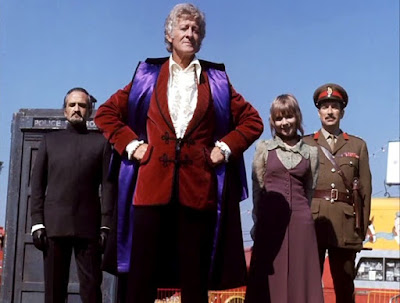When Andrew Cartmel was interviewed for the post of script editor on Doctor Who he was asked about what he would like to do with the show. He said he would like to use the programme to bring down the government. At the time, this referred to the Conservative government of Margaret Thatcher. The Happiness Patrol is very much intended as a satire on Thatcher and her -ism.
It shows how little the media were paying attention to the programme at this time, that it took them about 30 years to notice this.
The popular press were interested in when the Daleks might be reappearing, or whenever some Light Entertainment luminary had been cast in the series, but they obviously weren't actually watching the show.
Helen A, the ruler of the planet Terra Alpha is obviously based on Mrs Thatcher. She rules with a rod of iron, has little regard for the planet's society, and certainly doesn't entertain industrial unrest - even employing snipers to assassinate demonstrators. The Thatcher era in Britain saw various industrial disputes, the biggest being the year long Miners' Strike. Mrs Thatcher once claimed that there was no such thing as "Society", so she couldn't see what damage was being done to it by her policies. How can you damage what doesn't exist? Helen As methods don't really match those of Maggie T - more her good friend Pinochet of Chile and his ilk.
If Helen A is Thatcher, then Ronald Fraser's Harold C is the Iron Lady's husband Denis. Seen by the general public as a tipsy, somewhat brow-beaten man, thanks to John Wells' impersonations of him.
Some have also seen a gay subtext to this story. Harold C runs off with the rather camp Gilbert M at the end. Cy Town plays a moustachioed man who is executed by pink fondant. Moustaches went out of fashion with heterosexual men in the 1980's, but did become popular with gay men. The leather scene had a subset known as "Clones", for whom a moustache was obligatory. The way that agent provocateurs entrap the sad members of this society mirrors the entrapment of gay men in cottaging stings by the police.
And let's not forget that the TARDIS gets painted pink.
We have said before that Cartmell gained a lot of his inspiration from comics and graphic novels, including the hugely influential 2000AD. A Judge Dredd story revolved around a sweet which killed people - Umpty Candy - "the sweet that's too good to eat", created by a character called Uncle Umpty. The Kandyman makes sweets which kill people. The bowler hatted Trevor Sigma looks like Max Normal, another character from Judge Dredd.
The exterior scenes, filmed in studio, are so obviously studio-bound that it looks like a cartoon feel was intended.
The design of the Kandyman is, of course, more than inspired by the Bertie Bassett character which advertises such sweets as Liquorice Allsorts. Back in the 1970's, Tom Baker swapped Jelly Babies for Liquorice Allsorts, even though he still described them as Jelly Babies. Most people think that Jelly Babies first started with Baker, but they were first seen being offered by Troughton's Doctor.
Once again music plays a significant role in this story, as it has done more recently in the series (see Delta and the Bannermen). Earl Sigma is a Blues musician - the blues being synonymous for feeling down / depressed, which is what Helen A wants to stamp out. His harmonica playing even leads to the death of Helen A's pet, which prompts her personal revelation about grief.
The director wanted to record this story in black & white, as he felt it had a film noir feel.
The story title - "The Happiness Patrol" - conjures associations with "Joy Division", a band who were, ironically, famously miserablist.
Next time: it's the Silver Anniversary story, so the monsters most closely associated with silver are back...












































